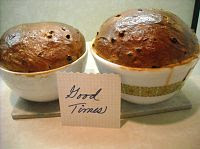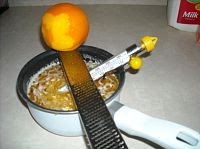This dish is one of my personal all time favorites, partially because it is so damn tasty and partially for it's ability to transcend tragedy and save lives! So please welcome today's guest blogger, the hostess with the mostess, Miss Sarah Goldfinger!
 |
| About the Author |
Salmon, Crispy Party Salmon
By Sarah Goldfinger
I don’t mean to be melodramatic, but this recipe has impressed boys, gotten me out of a serious jam, and is rumored to have saved someone’s life (let’s just say, without this salmon, this blog might not even exist...).
It comes from my mom—I have no idea where she got it, but I’ll ask… I suspect she told it to me somewhere in the mid to late 90s—late college or the early California years. It has been, and probably will be, my go-to recipe for years. The fun thing about it is that it seems very fancy when it’s actually quite simple—which is a great thing for a 20-something wanting to impress. I’ve made it for book club brunch, I’ve made it for good friends, I’ve made it for celebrities who’ve come to dinner parties (one of them named it Crispy Party Salmon), I’ve made it for 2 and made it for 12. I’ve even made it with Matzah for Passover!
Here’s the back story, feel free to skip right to the recipe, if you want --
THE JAM: When I first moved to LA I had no friends. I was a nanny and everyone I knew was 8 or 48, not 22. So that first Christmas Vacation I went up to Palo Alto to spend the time with my ex-boyfriend from college, we were still friends. I flew up thinking I was going to San Francisco. Remember, I was new to California. I thought northern California was just some tiny peninsula with all the places I’d ever heard of somehow dotted along the bike path, or something. Palo Alto may be the birthplace of every computer you’ve ever typed on, but it is the burbs. The boring burbs. And my ex didn’t have a license. He grew up in San Francisco where you pretty much could walk everywhere or take some public transit. Not so in Palo Alto. After about six days of padding around his mother’s house getting on each other’s nerves while his mom was in Italy trying to learn Italian, I had had it. I researched buses. I looked into cab fares. I just wanted to Get Out. Those all proved to be useless or way out of budget. But, his mom’s Saab was sitting in the driveway. We were free to use it, but it was a stick shift. I’d had two stick driving lessons in my life. On back country roads with a patient teacher and an old Toyota pick up truck whose clutch was so old, getting it stamped down was like doing a step aerobic workout (remember when pilates was only for injured ballerinas and we all did step aerobics? Ahh, maybe there should be a companion blog to this one for all the exercises we’ve exercised before!) I digress.
So, there I was: armed with an iron will, a lack of knowledge, and a series of bad decisions—sitting behind the wheel of his mother’s Saab. I will tell you two things about nice new Saabs: their clutch is a whole lot more sensitive than a 1975 pick up truck (I know--I don’t understand why that’s not their commercial tag line either) and they start in reverse. Reverse is the gear they start in. I made it about eight feet before the car’s rear end was wrapped around a tree trunk. Now, I know people say “wrapped around” all the time, but it was. It was like one of those cool decks where they cut the wood beams just-so around the trunk of an already existing tree. Nature and progress living in gentle harmony. This was like that, only the opposite. The mawing metal of the car had completely twisted and curved around the trunk of the tree. It was awful. And it wasn’t even mine to wreck. To date I think this event might be the worst (non-emotional) thing I’ve done to another person. She was coming home the next day. Like a dog’s nose in poop, I had about 30 hours to look at what I’d done. There was no solution. This wasn’t a “we better get the carpets clean before Mom comes home and finds that Jack Daniel’s stain.” I had totaled her car. I really didn’t know what else to do.
So, like a prayer, I turned to food. I made the salmon, always with the same side dishes: roasted red potatoes (very easy: small red potatoes, coat with olive oil, sprinkle Lipton’s onion soup mix, mix with hands, add couple fresh sprigs of rosemary. Bake at 350 for about 30 minutes), and a salad. As soon as she got home we told her. It was dark and she said she didn’t want to look at it. I think I felt relieved by this, but I may have just been numb. I fed her. And she ate. And it was nice. She told tales of Italy and made us decaf Illy espresso in her new on-the-stovetop silver coffee boiler, European style. The next day she looked at the car and gave me a giant hug. She wasn’t mad. At all. She told me it was the salmon.
Maybe she was just feeling heady from her trip or was glad I wasn’t hurt. But she never charged my insurance or me a nickel and she never held it against me. It was a remarkable act of grace that taught me a lot about how to be a good grown up, how to let go, how to be generous and not squeeze to tightly to stuff (even if the stuff is a nice new Saab)… But she credits the salmon.
CUT TO: A Year Later
THE LIFE RAFT: I’m still making the Salmon whenever I need to. But, now, instead of working as a nanny, I’m an assistant on a crazy TV show—finally with some peers of my own. Nicole and I are the front office assistants for the writers and producers and we become fast friends. There’s an assistant to the lead actor who often flits in and out and we can’t figure her out. She knows the actor from the theater world and she puts out a theater vibe with her clunky black mary janes and textured tights—normally someone I’d totally be friends with. But, all I ever see her ingest are cigarettes, lollipops, and Binaca breath spray—probably not someone I’d be friends with (I have a hard time trusting people who don’t like food).
Now I know it makes Nicole and I sound like severe mean girls when I say we had a bet going about whether this assistant, let’s call her Corinne, was an alcoholic or a bulimic, but does it help if I tell you that as we watched her get skinnier and skinnier, I finally reached out? My opening line was clunky, and will clearly reveal what side of the bet I’d placed... Asking her to come to dinner came out as, “If I fed you, would you eat?” She nodded quietly. Still mysterious, but open. We made a plan. I’d be house sitting for one of the families I used to nanny for and wanted to have some people over, you know, a casual (intervention) dinner party. Nicole, Corinne, and my friend Nanci, who didn’t work on the show would all be there.
The house was amazing with this great cook’s kitchen that made me feel like I was playing house in the best house ever. I made the salmon, and the roasted potatoes, and a salad. It’s all I knew and it had good history. We poured some wine and we talked. I fed her. And she ate. And ate. And eventually it was if we’d uncorked a fizzy bottle of Champagne. Corinne gushed forth about the stressful job and her wacky living arrangements and what was promised in Chicago versus the reality of what was true in LA and some health problems she was having and that she didn’t know which end was up and didn’t know how to behave on the show. She ate and she talked and she cried. And we realized she wasn’t an alcoholic or a bulimic. She was lonely. And scared. And we’d all been there. We’d created a safe space—we four women and a salmon. Within the year, Corinne and I were roommates and to this day I consider her one of my closest friends and I can’t remember the last time I saw her use Binaca! And though I think it was friendship and bravery on all fronts, Corinne credits the salmon with saving her life. It is, apparently, the life raft of main courses. Enjoy!
INGREDIENTS:
2 pounds of Salmon (serves 4-6)
¼ cup Honey
¼ cup Dijon Mustard
1 Bunch of Parsley (regular works better than Italian)
2 Slices of Pumpernickel (Dark Rye) Bread
½ cup of Pecans (my mom originally gave this recipe with walnuts , which are fine too, but I prefer the pecans)
DIRECTIONS:
Mix honey and mustard in a cup with a whisk—should be smooth.
Toast the bread in the toaster.
While that’s going: wash, dry and chop leaves off stems of parsley. Coarsely chop parsley leaves, put in a medium sized bowl.
Coarsely chop pecans, add to parsley.
Take slices of toasted bread and cut into small cubes, add to nuts and parsley.
Mix in bowl with hands.
Put tin foil on a cookie sheet, curl up the edges. Place fish on foil.
Drizzle 2/3 of the honey-mustard mixture on top of fish.
Sprinkle bread, parsley, and nut mixture on fish, making a nice thick crust.
Drizzle remaining sauce on top of the crust.
The sauce soaks into the bread and caramelizes the nuts.
Bake at 350 for 20 minutes then check done ness.
Eat and enjoy! Save lives if you have the chance!
Thank you, Sarah...for everything!



































